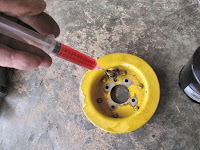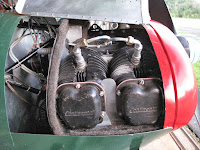The new EAA Flight Test Manual suggests determining the minimum fuel needed to assure safe flight in a full power climb. They had a good webinar on this back in February, 2013. They recommend flow at 150% of full power with the plane climbing at a 25 degree angle. For the Continental C-85 that means you need flow at 12.2 Gallons Per Hour or 26.1 ounces per minute. The climb angle part of this is to determine how much fuel needs to be in the tank so that the head pressure of that much fuel will cause flow at this rate.
The first part is to measure the flow rate to the Carburetor. The recommended procedure is to disconnect the fuel line to the carburetor and capture the fuel flowing from the hose in a container. That would be a great plan but I spent all this time fire proofing that hose and undoing it is more trouble than I want.
When I did the annual Condition Inspection I had to remove the filter screen in the carburetor and remove the drain plug from the float bowl. This gave me the idea of using the drain plug hole for the fuel exit. I also like the idea of knowing the flow rate I'm measuring is what really gets into the carburetor. I tried putting in a tube fitting in place of the plug, but it's not possible without removing the carb. heat box.
Instead I used a funnel to catch the flow from the hole. It worked well, but I had to use a bead of RTV to seal it to the bottom of the carb. This prevented a small amount of dripping from the back corner of the carburetor. I put the RTV on the funnel and then carefully positioned it to not get any in the drain hole. It cleaned up well when we were done.
The next step was to create a level base for my beaker. I wanted the outlet of the funnel close to the top of the beaker so the breeze wouldn't cause any mess.
I started with a full tank and the plane in the 3 point attitude. I wanted to know the system flowed well before experimenting with less fuel and a steeper angles.
The process is simple, just open the fuel valve, capture the flow in the beaker, and time how long the valve is open.
I put the beaker in a small tote just in case I didn't shut the valve off in time.
With a full tank I flowed 31.4 ounces of fuel in 47.37 seconds. That works out to 18.64 Gal/Hr, well above the 150% goal. At least we have good flow with a full tank.
In the 3 point attitude we have acceptable flow down to 3 gallons remaining in the tank.
In the three point attitude the tank will completely empty, which was my goal for assuring any water in the tank would flow to the gascolator. With just 2 quarts above empty it only flowed 8 ounces of fuel in 1 minute, which is only 3.75 GPH. That's way below our safe flight 12.2 GPH.

The next step was to increase the fuselage angle toward the 25 degree climb angle. We have 7 degrees in the 3 point attitude so we need another 18 degrees to get to 25. We know that the Sine of our 18 degree angle is the length of the opposite side of a right triangle divided by the hypotenuse. I know, it's trigonometry. If we lift the mains with the tail wheel on the ground the distance we lift them is the opposite side and the distance between the mains and tail wheel ( 169.875") is the hypotenuse. Ah the joys of a calculator, we need to raise the mains 52.5 inches to add 18 degrees. Ouch, that's not easy. For now I put the mains up on the trailer, which got us to 14.5 degrees, total angle. We'll fly with a full tank until I can measure the max climb angle Fly Baby actually will do.
The process is now the same, open valve, catch fuel, measure time the valve is open.
We started with an empty tank and added fuel until we found how much was needed to just get fuel to flow. With 2 gallons plus 3 quarts, fuel is just at the carb.
Then we added 1 gallon and measured the flow, 2 gallons, 3 gallons, etc. We like data.
The result is we get to the 150% flow rate with 5.6 gallons in the tank. I'm going to mark the fuel gauge wire, so when the plane is on the ground you can see that there are more than 6 gallons in the tank. This leaves 9 gallons of usable fuel. At some point I'll probably redesign the tank to eliminate the unusable fuel. For now I'll live with what we have. I expect the original 12 gallon CUB tank would have had about the same amount of usable fuel if we had done this test back in the 60's.
Clearly you could push flying past the 5.6 gallon minimum in level flight, but I like the idea of having enough fuel to make a safe go around if needed when landing. I never ran the old tank this low so it's not a big change, I'm just smarter now.
A good project.




































